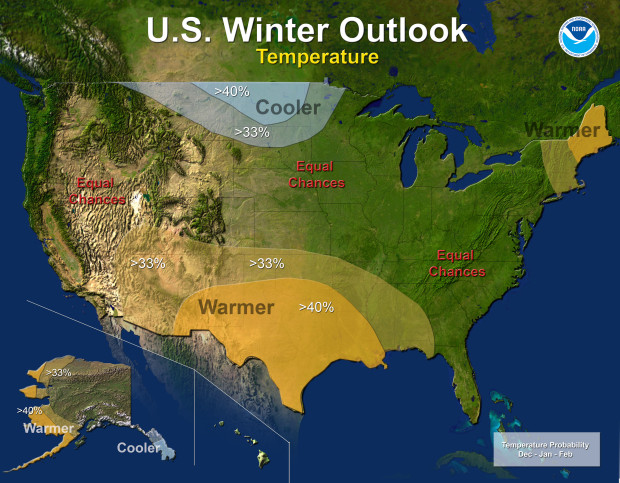The National Weather Service (NOAA) just released this U.S. Winter Outlook on November 21st, 2013 for December through February. So far, they’ve been dead on with Montana/Idaho/Wyoming getting above average precipitation.
Drought Likely to Persist or Develop in the Southwest, Southeastern U.S. This Winter
No strong climate pattern influence anticipated through upcoming winter season
November 21, 2013:

Winter is likely to offer little relief to the drought-stricken U.S. Southwest, and drought is likely to develop across parts of the Southeast as below-average precipitation is favored in these areas of the country, according to NOAA’s annual Winter Outlook announced today.
Drought has been an ongoing concern across parts of the Southwest and Texas for nearly three years, and after some relief during the past few months, drought is likely to redevelop during winter.

Sea surface temperatures across the equatorial Pacific have been near average since spring 2012, and forecasters expect that to continue through the winter. This means that neither El Niño nor La Niña is expected to influence the climate during the upcoming winter.
“It’s a challenge to produce a long-term winter forecast without the climate pattern of an El Niño or a La Niña in place out in the Pacific because those climate patterns often strongly influence winter temperature and precipitation here in the United States,” said Mike Halpert, acting director of NOAA’s Climate Prediction Center. “Without this strong seasonal influence, winter weather is often affected by short-term climate patterns, such as the Arctic Oscillation, that are not predictable beyond a week or two. So it’s important to pay attention to your local daily weather forecast throughout the winter.”
The Precipitation Outlook favors:
- Below-average precipitation in the Southwest, Southeast and the Alaskan panhandle.
- Above-average precipitation in the Northern Rockies, particularly over Montana and northern Wyoming and in Hawaii.
The Temperature Outlook favors:
- Below-average temperatures in the Northern Plains and the Alaskan Panhandle.
- Above-average temperatures in the Southwest, the South-Central U.S., parts of the Southeast, New England and western Alaska.
The rest of the country falls into the “equal chance” category, meaning that there is not a strong or reliable enough climate signal in these areas to favor one category over the others, so they have an equal chance for above-, near-, or below-normal temperatures and/or precipitation.
The Climate Prediction Center produces the U.S. Winter Outlook to give American communities the best possible scientific prediction of how the winter may shape up across the nation. This outlook supports local and state governments in their effort to plan for public needs during the winter, and large and small businesses as they plan for winter impacts on things like transportation, market demand for goods and services, and finances. Building a Weather-Ready Nation is a collective effort to improve America’s resilience to extreme weather and climate by empowering the public to make fast, smart and life-saving decisions.
This seasonal outlook does not project where and when snowstorms may hit or provide total seasonal snowfall accumulations. Snow forecasts are dependent upon the strength and track of winter storms, which are generally not predictable more than a week in advance.